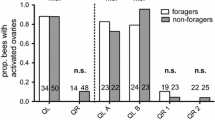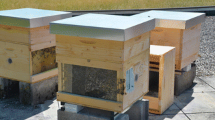Abstract
Hormone analyses and exocrine gland measurements were made to probe for physiological correlates of division of labor among similarly aged adult worker honey bees (Apis mellifera L.). Middle-age bees (ca. 2 weeks old) performing different tasks showed significant differences in both juvenile hormone (JH) biosynthesis rates and hemolymph titers; guards and undertakers had high JH, and wax producers and food storers, low JH. Guards and undertakers had similar hormone levels to foragers, even though they were 10 days younger than foragers. No differences in JH were detected among young bees (1-week-old queen attendants and nurses) or older bees (3–4 week-old pollen foragers, non-pollen foragers, and soldiers). Hypopharyngeal gland size was inversely correlated with worker age and rate of JH biosynthesis, but soldiers had significantly larger hypopharyngeal glands than did foragers, despite their similar age and JH level. Results from soldiers indicate that exocrine gland development is not always linked with age-related behavior and endocrine development; they also support the recent claim that soldiers constitute a group of older bees that are distinct from foragers. Hormonal analyses indicate that the current model of JH's role in honey bee division of labor needs to be expanded because high levels of JH are associated with several other tasks besides foraging. JH may be involved in the regulation of division of labor among similarly aged workers in addition to its role in age-related division of labor.
Similar content being viewed by others
Abbreviations
- JH:
-
Juvenile hormone
- RIA:
-
radioimmunoassay
- CA:
-
corpora allata
- HPLC:
-
high performance liquid chromatography
- TLC:
-
thin layer chromatography
References
Breed MD (1983) Correlations between aggressiveness and corpora allata volume, social isolation, age and dietary protein in worker honeybees. Insectes Sociaux 30:482–495
Breed MD, Robinson GE, Page RE (1990) Division of labor during honey bee colony defense. Behav Ecol Sociobiol 27:395–101
Brouwers EVM (1982) Measurement of hypopharyngeal gland activity in the honeybee. J Apic Res 21:193–198
Brouwers EVM (1983) Activation of the hypopharyngeal glands of honeybees in winter. J Apic Res 22:137–141
Butler CG (1973) Perception of the queen by workers in the honeybee colony. J Apic Res 12:159–166
Calderone NW, Page RE (1988) Genotypic variability in age polyethism and task specialization in the honey bee, Apis mellifera (Hymenoptera: Apidae). Behav Ecol Sociobiol 22:17–25
Crailsheim K (1991) Interadult feeding of jelly in honeybee (Apismellifera L.) colonies. J Comp Physiol B 161:55–60
Crailsheim K (1992) The flow of jelly within a honeybee colony. J Comp Physiol B 162:681–689
Crailsheim K, Stolberg E (1989) Influence of diet, age and colony condition upon intestinal proteolytic activity and size of the hypopharyngeal glands in the honeybee (Apis mellifera L.). J Insect Physiol 35:595–602
De Kort CAD, Koopmanschap AB, Strambi C, Strambi A (1985) The application and evaluation of a radioimmunoassay for measuring juvenile hormone titres in Colorado beetle haemolymph. Insect Biochem 15:771–775
Denlinger DL, Shrukla M, Faustini DL (1984) Juvenile hormone involvement in pupal diapause of the flesh fly Sarcophaga crassipalpis: regulation of infradian cycles of O2 consumption. J Exp Biol 109:191–199
Fergusson LA, Winston ML (1988) The influence of wax deprivation on temporal polyethism in honey bee (Apis mellifera L.) colonies. Can J Zool 66:1997–2001
Fluri P, Lüscher M, Wille H, Gerig L (1982) Changes in weight of the pharyngeal gland and haemolymph titres of juvenile hormone, protein and vitellogenin in worker honey bees. J Insect Physiol 28:61–68
Free JB, Ferguson AW, Simpkins JR (1992) The behaviour of queen honeybees and their attendants. Physiol Entomol 17:43–55
Goodman WG, Coy DC, Baker FC, Xu L, Toong YC (1990) Development and application of a radioimmunoassay for the juvenile hormones. Insect Biochem 20:357–364
Goodman WG, Huang Z-Y, Robinson GE, Strambi A, Strambi C (1993) A comparison of two juvenile hormone radioimmunoassays. Arch Insect Biochem Physiol 23:147–152
Hagenguth H, Rembold H (1978) Identification of juvenile hormone 3 as the only juvenile hormone homolog in all developmental stages of the honey bee. Z Naturforsch 33C:847–850
Harrison JM (1986) Caste-specific changes in honeybee flight capacity. Physiol Zool 59:175–187
Hassanein MH (1952) The effects of infection with Nosema apis on the pharyngeal salivary glands of the worker honey-bee. Proc R Entomol Soc Lond A 27:22–27
Haydak MH (1957) Changes with age in the appearance of some internal organs of the honeybee. Bee World 38:197–207
Huang Z-Y (1990) A simple in vivo estimation of hypopharyngeal gland activity in honeybees (Apis mellifera). J Apic Res 29:75–81
Huang Z-Y, Robinson GE (1992) Honeybee colony integration: worker-worker interactions mediate hormonally regulated plasticity in division of labor. Proc Natl Acad Sei USA 89:11726–11729
Huang Z-Y, Otis GW, Teal PEA (1989) Nature of brood signal activating the protein synthesis of hypopharyngeal gland in honey bees, Apis mellifera (Apidae: Hymenoptera). Apidologie 20:455–164
Huang Z-Y Robinson GE, Tobe SS, Yagi KJ, Strambi C, Strambi A, Stay B (1991) Hormonal regulation of behavioural development in the honey bee is based on changes in the rate of juvenile hormone biosynthesis. J Insect Physiol 37:733–741
Hunnicutt, D, Toong YC, Borst DW (1989) A chiral specific antiserum for juvenile hormone. Am Zool 29:48a
Jaycox ER (1976) Behavioral changes in worker honey bees (Apis mellifera L.) after injection with synthetic juvenile hormone (Hymenoptera: Apidae). J Kans Entomol Soc 49:165–170
Jaycox ER, Skowronek W, Gwynn G (1974) Behavioral changes in worker honey bees (Apis mellifera) induced by injections of a juvenile hormone mimic. Ann Entomol Soc Am 67:529–534
Jeanne RL (ed) (1987) Inter-individual behavioral variability in social insects. Westview Press, Boulder, Colorado
Kaatz H-H, Hagedorn HH, Engels W (1985) Culture of honeybee organs: development of a new medium and the importance of tracheation. In Vitro Cell Dev Biol 21:347–352
King GE (1933) The larger glands in the worker honey-bee. A correlation of activity with age and with physiological functioning. Ph.D. Thesis, University of Illinois, Urbana, Illinois
Maurizio A (1954) Pollenernhrung und Lebensvorgänge bei der Honigbiene. Landw Jrb Schweiz 68:115–182
Moore AJ, Breed MD, Moore MJ (1987) The guard honey bee: ontogeny and behavioural variability of workers performing a specialized task. Anim Behav 35:1159–1167
Muller EJ, Hepburn HR (1992) Temporal and spatial patterns of wax secretion and related behavior in the division of labour of the honeybee (Apis mellifera capensis). J Comp Physiol A 171:111–115
O'Donnell S, Jeanne RL (1993) Methoprene accelerates age polyethism in workers of a social wasp (Polybia occidentalis). Physiol Entomol 18:189–194
Oster GF, Wilson EO (1978) Caste and ecology in the social insects. Princeton University Press Princeton, New Jersey
Page RE, Robinson GE (1991) The genetics of division of labour in honey bee colonies. Adv Insect Physiol 23:117–171
Pellet FC (1938) History of American beekeeping. Collegiate Press, Ames, IA
Phillips EF (1915) Beekeeping. MacMillan, New York
Pickard RS, Kither GY (1983) An evaluation of shaking and displacement methods for separating a sample of honeybees with large hypopharyngeal glands from the remainder of a colony. J Apic Res 22:101–106
Pratt GE, Tobe SS (1974) Juvenile hormones radiobiosynthesized by corpora allata of adult female locusts in vitro. Life Sei 14:575–86
Robinson GE (1985) Effects of a juvenile hormone analogue on honey bee foraging behaviour and alarm pheromone production. J Insect Physiol 31:277–282
Robinson GE (1987a) Regulation of honey bee age polyethism by juvenile hormone. Behav Ecol Sociobiol 20:329–338
Robinson GE (1987b) Modulation of alarm pheromone perception in the honey bee: evidence for division of labor based on hormonally regulated response thresholds. J Comp Physiol A 160:613–619
Robinson GE (1992) Regulation of division of labor in insect societies. Annu Rev Entomol 37:637–665
Robinson GE, Page RE (1988) Genetic determination of guarding and undertaking in honey-bee colonies. Nature 333:356–358
Robinson GE, Page RE (1989) Genetic determination of nectar foraging, pollen foraging, and nest-side scouting in honey bee colonies. Behav Ecol Sociobiol 24:317–323
Robinson GE, Strambi A, Strambi C, Paulino-Simões ZL, Tozeto SO, Barbosa JMN (1987) Juvenile hormone titers in Africanized and European honey bees in Brazil. Gen Comp Endocrinol 66:457–459
Robinson GE, Page RE., Strambi C, Strambi A (1989) Hormonal and genetic control of behavioral integration in honey bee colonies. Science 246:109–112
Robinson GE, Strambi C, Strambi A, Feldlaufer MF (1991) Comparison of juvenile hormone and ecdysteroid haemolymph titers in adult worker and queen honey bees (Apis mellifera). J Insect Physiol 37:929–935
Rösch GA (1925) Untersuchungen über die Arbeitsteilung im Bienenstaat, I. Teil: Die Tätigkeiten im normalen Bienenstaate und ihre Beziehungen zum Alter der Arbeitsbienen. Z Vergl Physiol 2:571–631
Rösch GA (1930) Untersuchungen über die Arbeitsteilung im Bienenstaat, II. Die Tätigkeiten der Arbeitsbienen unter experimentell veränderten Bedingungen. Z Vergl Physiol 12:1–71
Rutz W, Gerig L, Wille H, Lüscher M (1974) A bioassay for juvenile hormone (JH) effects of insect growth regulators (IGR) on adult worker honeybees. Mitt Schweiz Entomol Ges 47:307–313
Sakagami SF (1953) Untersuchungen über die Arbeitsteilung in einem Zwergvolk der Honigbienen. Beiträge zur Biologie des Bienenvolkes, Apis mellifera L. I. Jpn J Zool 11:117–185
SAS Institute Inc. (1985) SAS user's guide: Statistics. Carry, North Carolina
Sasagawa H, Sasaki M, Okada I (1989) Hormonal control of the division of labor in adult honeybees (Apis mellifera L.) I. Effect of methoprene on corpora allata and hypopharyngeal gland, and its α-glucosidase activity. Appl Entomol Zool 24:66–77
Seeley TD (1979) Queen substance dispersal by messenger workers in honeybee colonies. Behav Ecol Sociobiol 5:391–415
Seeley TD (1985) Honey bee ecology. Princeton University Press, Princeton
Seeley TD (1989) Social foraging in honey bees: how nectar foragers assess their colony's nutrit ional status. Behav Ecol Sociobiol 24:181–99
Simpson J (1960) The functions of the salivary glands of Apis mellifera J Insect Physiol 4:107–121
Simpson J, Riedel IBM, Wilding N (1968) Invertase in the hypopharyngeal glands of the honeybee. J Apic Res 7:29–36
Soudek S (1927) Hltanove Zlazy Vcely Medonosne (The pharyngeal glands of the honey bee). Bull Ecole Brno 10:1–63
Tobe SS, Pratt GE (1974) The influence of substrate concentrations on the rate of insect juvenile hormone biosynthesis by corpora allata of the desert locust in vitro. Biochem J 144:107–33
Van der Blom J (1992) Individual involvement in queen-attending of worker honeybees. Insectes Sociaux 39:237–249
Visscher PK (1983) The honey bee way of death: necrophoric behaviour in Apis mellifera. Anim Behav 31:1070–1076
Wilson EO (1971) The insect societies. Harvard University Press, Cambridge
Wingfield JC (1985) Short term changes in plasma levels of hormones during establishment and defense of a breeding territory in male song sparrows, Melospiza melodia. Horm Behav 19:174–187
Wingfield JC, Wada M (1989) Male-male interactions increase both luteinizing hormone and testosterone in the song sparrow, Zonotrichia melodia: time course and possible neutral pathways. J Comp Physiol A 166:189–194
Winston ML (1987) The biology of the honey bee. Harvard University Press, Cambridge
Author information
Authors and Affiliations
Rights and permissions
About this article
Cite this article
Huang, ZY., Robinson1, G.E. & Borst, D.W. Physiological correlates of division of labor among similarly aged honey bees. J Comp Physiol A 174, 731–739 (1994). https://doi.org/10.1007/BF00192722
Accepted:
Issue Date:
DOI: https://doi.org/10.1007/BF00192722




